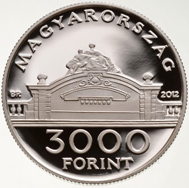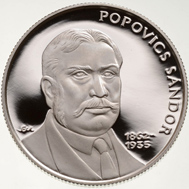January 10, 2013 – Sándor Popovics (1862-1935) was a Hungarian politician and financial expert who played a key role in the creation of the independent Hungarian central bank – the Magyar Nemzeti Bank – and was its first governor. He was called the “eternal champion of the treasury, and the great aristocrat of bureaucracy.”
Hungary / 3,000 Forint / 925 silver / 20 g / 34 mm / Design: Márta Csikai / Mintage: 2,000 (BU), 4,000 (Proof).
To commemorate his birth on October 22, 1862, the bank, also the owner of the Hungarian Mint, is issuing a 3,000 forint silver coin. The obverse of the coin, designed by Márta Csikai, depicts the group of statues sculpted by József Róna on the facade of the National Bank building, with a portrait of Popovics on the reverse. 4,000 proof versions are being issued, along with only 2,000 brilliant uncirculated pieces. It is 34 mm in diameter and contains 20 grams of .925 (sterling) silver. The designer is Márta Csikai.
A statement from the national bank said, “We honour Popovics as an exemplary representative of the Monarchy and later of the independent Hungarian state, a man who never forgot and indeed proudly proclaimed his Hungarian identity, dedicating his skills and expertise to the betterment of the Hungarian nation. His professional commitment is well reflected in the words spoken to his staff upon leaving the Ministry of Finance, “… whoever has once taken the oath of financial service has taken on an indelible mark and must necessarily remain a champion of the treasury forever after.”
Popovics graduated from the Budapest scientific university with a doctorate in law. His career in finance began in 1884, when as a 22-year old he started working at the Ministry of Finance under Minister Sándor Wekerle. From 1892 on, he was already a department adviser and one of Wekerle’s closest colleagues in preparing the korona currency reform. His talent was clearly recognized and he was steadily promoted: from 1903 he served as state secretary and in 1909 he was appointed governor of the Austro-Hungarian Bank. He summarized the essence of his economic policy views as follows, “one must be conservative in terms of principles, and progressive in recognizing and executing the tasks.”
At the end of World War I, he briefly served as Minister of Finance in the Wekerle government. He later played a key role in the creation of the independent Hungarian central bank – the Magyar Nemzeti Bank – and was the first governor of that institution. He began his work as head of the central bank on June 24, 1924. His first move was to stabilize the Hungarian korona, which had suffered from inflation after WWI, and then pressed forward with the introduction of the new currency, the pengo. He took over the handling of the state’s accounts and the management of state debt. Through his interest rate and credit policies and the principles and practices he applied in the discounting of bills, he was responsible for managing Hungary’s sovereign debt. His work also covered management of the foreign exchange regime.
Popovics had an active social life, wrote publications and played an active role in scientific matters and later as a politician to a limited degree. He was an honorary member of the Hungarian Academy of Sciences from 1924, a member of the upper chamber of parliament from 1927 and was Vice-President of the Hungarian Academy of Sciences in 1933-34. One of his most important pieces of work was “The Fate of Money During War”, published in 1926, and “Currency Stability”, published in 1929. His general sociological observations were collected in the work “The Economic Ramifications of Social Organisation”.
For more information visit the website of the Hungarian Mint.





